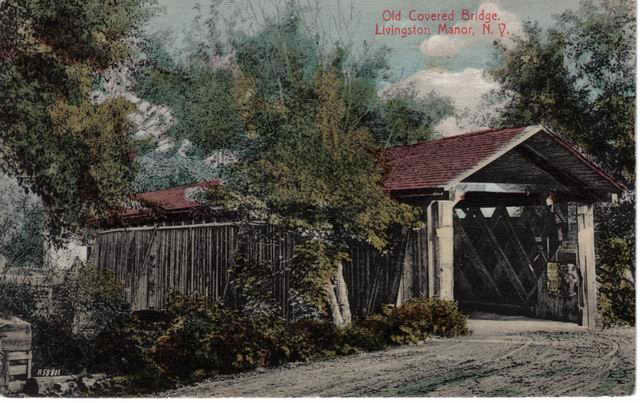
Livingston Manor Covered Bridge - Is this the original that was by the Owl before the Iron bridge

In my search for the missing twelve feet of the Jacktown Bridge, I
went to its current location a while ago to measure up the remaining
portion, in hopes that it may give some clues to its diminutive
size. One characteristic that was evident in the construction of this
bridge was the engineering principles used in the design of the
trusses, especially over the bridge's abutment.
The bridge photograph that Harold has posted on the Manor history
site shows a good view of the end of one of these trusses through the
Main street entrance portal. As you can see, the truss is made up of
diagonal beams, criss-crossed, and tied into the upper and lower
horizontal beams, called stringers. This type of design, called the
Towne Truss system, is an ingenious was of shifting any weight from
the inner portions of the bridge out to its abutments, at the ends of
the bridge. What was unusual with this bridge, as I noticed when I
measured it, were the three outside diagonals at the end of the
trusses.
Looking at the bridge's image, you'll notice that the three end
diagonal beams of the truss, whose bottoms point toward the
riverbank, are not parallel, but come together as they approach the
bottom of the bridge. They actually do come together, as designed,
under the deck of the bridge, onto the abutment, adding more strength
and increasing the load weight the bridge can handle.
When Harold posted the picture, I thought this would be a good clue
to use for a positive identification. But to make certain, I visited
the other two bridges in our town to verify this difference in
construction between the three. You know what, all three had this
design. And you know what else, all three bridges were built by John
Davidson.
It seems that Davidson used the locally common Towne Truss design,
but added this variation; sort of like his signature. Now to make
sure of this, this week I visited other bridges in our area;
Downsville, Hamden, Fitch's and Hall's Mills, to see if they had this
design. They did not. At least for the bridges in our area, we have
an original design; the "Davidson Variation".
Does this design exist in other areas? Maybe, or maybe not. Do any of
you folks live near covered bridges? If so, do they show this type of
design, the "Davidson variation"?
fred
In looking at the old postcard of the Jacktown Bridge in its bucolic
setting, one would never envision the trouble, aggravation and
politics that it would generate. With the bridge in disrepair in
1894, and the town trying to find means to either fix it or replace
it with an iron bridge, Eli Starr fired off the following, rambling,
article;
FRED June 1, 2004
"Dissatisfaction at the manner in which the law and the rights of the
people have been trodden under foot at every point in the "bridge
deal" has been widespread and strong.
"The idea that a bridge to cross the old frog pond at Livingston
Manor must be made to cost enough to double the tax rate of the town
in order to gratify the whims or pockets of a half dozen individuals
is not relished by many.
"As a means of getting an expression of the wishes of the taxpayers
of the town on this subject in a fair and honorable way, twenty-five
representative taxpayers and prominent business men united in
notifying the clerk of the (ring) town to call for a special town
meeting to instruct the town officers in the matter. Said notice was
filed with the clerk August 8th and the names therein included
representatives from six of our different school districts.
"Now as a fitting climax for the records of town board which never
existed and unlawful acts of individual officers, comes a notice
calling the special town meeting on August 30, which, if legal, yet
is one of the smallest, most contemptible acts ever resorted to in
this of any public matter.
"The annual reunion of the G.A.R. Posts in Sullivan county has been
advertised for several weeks to take place at Roscoe of August 30.
The date, location, etc., of the reunion is determined by the
commanders of all the Posts in the county.
"A large amount of money has to be expended by the local Post and
much assistance is depended on and gladly given by all the citizens
of the place. Days and weeks of labor are given to make this meeting
a success, and after exerting themselves in every way, the local
Posts of veterans, now reduced to small numbers, expect every cent of
money they make in charity among old soldiers.
"Rogues are always cowards. Do the McShanes and Crokers of Livingston
Manor expect to gain their points by petty meanness? Must the G.A.R.
be injured in order that they may escape the consequences of their
acts? Is it not true town officers acted for the town and not
individuals and foreign corporations? And what honorable man would
not rather pay for the frog pond bridge out of his own pocket than
bear the action of the contemptible acts being done to consummate this
rape on the taxpayers of the Town of Rockland."
Roscoe-Rockland Review, August 22, 1894